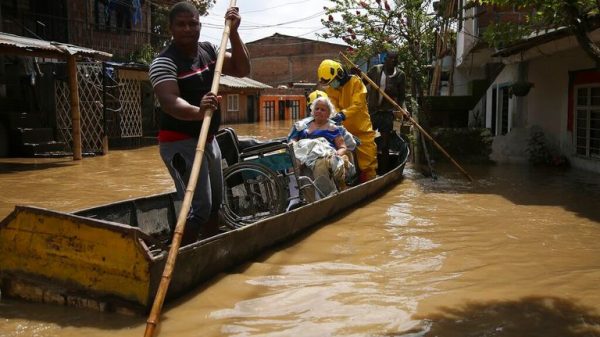High in the mist-shrouded Himalayas, a winding mountain road opens to a clearing in the pine forested valley, revealing rows of uniform Tibetan-style houses, each topped with a Chinese flag.
Construction is booming in this remote place. Piles of logs and other building materials line the road. On a nearby hillside, cranes tower over rising housing blocks.
“They are building resettlement houses here,” says the Chinese travel vlogger who captured these scenes last year, speaking into his phone on a roadside. “When people live and settle here, it undeniably confirms that this is our country’s territory.”
But the village – known as Demalong and formally founded in March last year with a community of 70 families, according to a government notice seen in the footage – is not only located in territory claimed by the world’s ascendent superpower.
It is one of a string of Chinese settlements that also fall well within the border shown on official maps of Bhutan – a Buddhist kingdom of fewer than 1 million people that’s never agreed on a formal international border with China.
For centuries, herders looking for summer pastures were the main presence in this harsh and inhospitable region some 14,000 feet (4,200 meters) above sea level in the eastern Himalayas. But now, there is a growing population as the Chinese government incentivizes hundreds of people to settle there from across Tibet, the region of China that borders Bhutan.
Those settlements show another, quieter front in China’s expanding efforts to assert its control over disputed, peripheral territories – also playing out in the South and East China Seas – as Chinese leader Xi Jinping seeks to bolster national security and enhance China’s position over its rivals.
Bhutan and China have been holding yet-unresolved border talks for decades. Looming in the backdrop of those discussions is India, China’s biggest regional rival and Bhutan’s close diplomatic ally.
The nuclear-armed neighbors have previously gone to war and more recently engaged in a series of skirmishes over their disputed 2,100-mile (3,379-kilometer) border, which straddles Bhutan – and, in Beijing’s eyes, makes the small Himalayan nation all the more critical to its national security.
A comparison of China’s official map of the Tibet Autonomous Region and Bhutan’s national map published in its 2023 Statistical Yearbook show this development is located in territory claimed by both countries.
Bhutanese authorities, however, have repeatedly rejected previous reports of Chinese encroachment, including in a foreign media interview last year when then-Prime Minister Lotay Tshering “categorically” denied that China had been building in Bhutan’s territory.
“The map of Bhutan covering the northern border will be finalized in accordance to the demarcation of the Bhutan-China border,” the ministry’s statement said. It also pointed to the two countries’ boundary talks and said Bhutan was “confident that the northern border will be finalized in the near future.”
“China’s construction activities in the border region with Bhutan are aimed at improving the local livelihoods,” a ministry statement said. “China and Bhutan have their own claims regarding the territorial status of the relevant region, but both agree to resolve differences and disputes through friendly consultations and negotiations.”
The construction has taken place in border regions in northeast Bhutan and the west of the kingdom – near the disputed border between India and China, according to the research. The findings, also described by Barnett in The Diplomat, add to his 2021 Foreign Policy magazine report on earlier construction in the same northern area – and document what the latest research describes as a new “surge” in building there since early last year.
High-altitude rivalry
The blurry boundaries through the Himalayan peaks and plateaus separating China and its southern neighbors are often relics of imperial era agreements and nomadic routes – now charged with the nationalist rhetoric and military might of New Delhi and Beijing.
Landlocked by both, Bhutan has long navigated carefully between India – its largest development and trading partner, which until 2007 effectively controlled its foreign policy – and China, an economic and military giant with whom it has no formal diplomatic ties.
Bhutan’s place in their dispute was thrown into the spotlight in 2017, when the kingdom accused the Chinese army of building a road “inside Bhutanese territory” in the Doklam area, near a strategic and disputed junction between all three countries along Bhutan’s west.
Then, Indian troops moved into the area to block China – sparking a tense, 73-day standoff that threatened to pitch the rivals into conflict.
Though not part of India’s territorial claims, Doklam is close to the so-called “chicken’s neck,” or Siliguri Corridor, a vital artery between New Delhi and its far northeastern states. China claims Doklam has been its territory “since ancient times.”
Ultimately diffused, the incident was one more reminder for Beijing of the volatility of the unresolved border.
India and China reached an agreement on military disengagement along a section of their disputed border earlier this month – in a step toward easing tensions there.
However, strengthening its position in that rivalry has been a driving force for Beijing, experts say, as it extends its foothold in lands traditionally claimed by Bhutan – and enlists its citizens to relocate there to press its counterclaim.
“Knowing India has a strong presence in Bhutan, China naturally becomes vulnerable in the bordering region,” said Rishi Gupta, assistant director at the Asia Society Policy Institute in New Delhi.
“This vulnerability compels China to enhance its influence in Bhutan and assert its territorial claims more aggressively, seeking to counterbalance India’s strategic partnerships in the area.”
One year prior to the 2017 standoff, Beijing was already starting a major bid to bolster its claims by building roads and villages in the Jakarlung valley – along another China-Bhutan frontier far to the northeast of Doklam.
The buildup follows what observers say were long-standing efforts by China to convince Bhutan’s leaders to cede their claims in the west around Doklam – in exchange for Beijing giving up its claims to the northern areas.
In 2016, China founded Jieluobu, its first official village in the Jakarlung valley. Two years later, Jieluobu was branded a model “border xiaokang village” – one of hundreds of such villages built or upgraded in recent years along China’s western and southern frontiers.
The “xiaokang” – or “moderate prosperity” – villages along China’s borders have been billed as part of Beijing’s scheme to eradicate poverty and improve living conditions in its far-flung frontiers.
But experts say these villages are also part of Xi’s vision to use civilian settlements to solidify control of China’s border, amid perceived threats of foreign encroachment and infiltration – and a growing obsession with security.
“Only when there are people can the border remain stable,” the leader is often quoted as saying by officials in frontier regions.
By 2022, more than 600 “border xiaokang villages” – including Jieluobu – had been completed in Tibet, boosting its border population by 10.5%, the regional government said in its annual work report.
“It is no doubt that the villages are aimed to strengthen China’s territorial claims and control of the border regions, especially the disputed areas,” said Yun Sun, director of the China program at the Stimson Center think tank in Washington.
“Once the Chinese villagers are there, China has causes for stationing troops and performing administrative control. The strategy has a long history in China, tracing back as early as the Han dynasty,” she said.
No place anybody would choose
Chinese construction that began in the Jakurlung valley in 2016 has ramped up since last year relative to earlier periods, according to the research by SOAS’s Barnett, based on satellite imagery.
As of this summer, more than 2,000 residential units – estimated to have space for thousands of people – had been built in multiple settlements across both areas, according to the report.
That buildup has also been supported by an expanding network of roads, which geointelligence researcher Damien Symon says have progressed south from China into Bhutan over recent years.
“None of the roads connect into Bhutan, they start from the Chinese border and end in forest areas. There is no connectivity to existing Bhutanese roads or villages,” said Symon, of analysis collective The Intel Lab, who in a December 2023 report for London-based think tank Chatham House tracked new Chinese construction “across the contested border with Bhutan” in the north.
Road access is crucial for new settlements in the Jakarlung valley, which Chinese reports say used to be cut off from the outside world by heavy snow for half the year.
“These are not places anybody would normally choose to relocate to, because they are either extremely high or extremely exposed to the elements,” Barnett said.
To populate the cold, damp valley, officials in Tibet entice settlers from across the region with spacious new homes and generous subsidies.
In Jieluobu, the Tibetan herders moved into two-story houses with courtyards. Residents aged 16 and older are eligible for an annual subsidy of more than 20,000 yuan (about $2,800), state media reported.
Patriotic education is part of everyday life in Jieluobu. In 2021, the village held 150 study sessions on Xi’s speeches, party policies and history, Mandarin Chinese and border defense, state media reported. Since then, the village has also undergone a major expansion.
Meanwhile, in the southeastern part of the valley, Demalong has added 235 new homes since last year and aims to build a kindergarten and a clinic, according to government statements. It also has a military compound, the travel blogger’s video shows.
Since late September, a new wave of residents has moved into Demalong, Jieluobu, Semalong and Qujielong from as far as Nagqu, a city in northern Tibet some seven hours’ drive away, according to a local government notice and videos shared by relocatees on Chinese social media.
The new families, arriving in long columns of vans, coaches and trucks escorted by police cars, were greeted by red banners and traditional Tibetan dances, social media footage shows.
‘No intrusion’
Bhutan has repeatedly denied that Chinese construction has taken place in its territory.
Asked in March last year about reports of China building in the kingdom’s north, then-Prime Minister Lotay Tshering told Belgian outlet La Libre, “We are not making a big deal of it because it’s not in Bhutan.”
“We have said categorically that there is no intrusion as mentioned in the media,” he said. “This is an international border and we know exactly what belongs to us.”
In a separate interview with India’s The Hindu about six months later, the former prime minister, whose government was replaced in elections earlier this year, reiterated that “there are no real differences between China and Bhutan, but there is an un-demarcated border dating back to Tibet-Bhutan ties,” referring to the period before Tibet’s 1951 official annexation by Beijing.
As early as 2020, Bhutan’s ambassador to India said there was “no Chinese village inside Bhutan,” following Indian media reports about such development in the kingdom’s western borderlands.
That appears to be in sharp contrast to recent decades when Bhutan repeatedly protested what it claimed were incursions into its territory by Chinese soldiers and Tibetan herders. In 1997, Thimphu told Beijing that Tibetan herdsmen had been intruding into the Jakarlung valley and even constructed sheds there, according to Bhutan’s National Assembly records cited by Barnett.
In a 1998 pact, the two countries agreed to maintain the status quo in the border region as they continue talks to resolve the “boundary question.”
Observers say Bhutan’s rhetoric on this issue has become increasingly opaque in recent years, and some wonder whether the kingdom’s muted comments are because it’s already reached a tacit understanding with China to give up some territorial claims.
Others suggest Bhutan’s priority may be to keep relations stable so they can finally reach a deal – with the potential to ease the uncertainty of the countries’ power imbalance and bring the economic benefits of normalized ties.
“Most Bhutanese would love to see the borders demarcated and settled and a new chapter of friendly relations with China,” said Bhutanese scholar Karma Phuntsho.
But while Bhutan remains “keen to solve the border issues with China,” the remote border areas have little impact on Bhutanese peoples’ livelihoods, so, “the countries are taking time to reach the best mutually beneficial solutions,” he added.
Other observers take a more pointed view.
The Bhutanese “have realized that they have no way in which they can get back anything which the Chinese have occupied, and they lack the capacity … to police the border, let alone the military capacity to retrieve anything from the border,” said Manoj Joshi, a distinguished fellow at the Observer Research Foundation in New Delhi.
“So at one level, they have taken the position that they will try and resolve the border issue … pending that settlement, they don’t want anything to come up.”
Despite the negotiations over the decades, the kingdom has already shed land to China.
Bhutan’s official maps have lost a parcel of land to its northwest and the Menchuma valley and plateau in its northeast, according to Barnett. That northwest parcel, which includes Kula Kangri mountain, is often cited as covering some 400 square kilometers (154 sq miles).
“These areas fall north to the traditional boundary between Bhutan and China,” its statement said.
In 2021, Bhutanese and Chinese officials agreed to a “road map” to expedite settling their border. They picked up formal talks last October for the first time since the Doklam standoff, with Bhutan’s foreign minister making a rare visit to Beijing.
There, Chinese Foreign Minister Wang Yi assured counterpart Tandi Dorji that Beijing was ready to “fix and develop China-Bhutan friendly relations in legal form.”
Regardless of how each side defines the location of these developments, they appear to be part of a long-term plan for China to strengthen its position and apply pressure along the yet un-demarcated border.
This year, a local government chief from a county in Tibet has visited the villages in the Jakarlung valley at least twice to inspect construction projects and check in with residents.
During a visit in April, the official reminded local cadres and residents of their mission.
“(We’re) lacking oxygen but not spirit, enduring hardship without fear, overcoming higher altitudes with an even higher sense of purpose,” he said, quoting a 2020 speech by Xi.


























